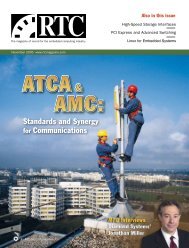Inrush Current Control Technology Boosts Power Converter Reliability
Inrush Current Control Technology Boosts Power Converter Reliability
Inrush Current Control Technology Boosts Power Converter Reliability
Create successful ePaper yourself
Turn your PDF publications into a flip-book with our unique Google optimized e-Paper software.
<strong>Technology</strong> Focus:<br />
ATCA Blades and Systems Roundup<br />
ATCA Base Switch Blade Provides<br />
24 Gbit Ethernet Ports<br />
ATCA has carved out a respectable niche in<br />
the military where high-density computing<br />
and net-centric communications are a priority. A<br />
24-port GbE AdvancedTCA (ATCA) Multilayer<br />
Base Switch Blade is based on the Broadcom<br />
BCM56312 switch chip. It supports up to thirteen<br />
GbE ports for a 14-slot PICMG 3.0 ATCA system,<br />
with six egress GbE ports and two 10GbE SFP+<br />
uplink ports via front panel access. The aTCA-<br />
3150 from Adlink <strong>Technology</strong> incorporates<br />
Broadcom’s Fastpath networking software and<br />
is designed for ATCA adopters (NEPs & TEMs)<br />
who require AMC modularity, Gigabit layer 3<br />
switching, a scalable control-plane engine and<br />
high-availability Base Interface.<br />
The aTCA-3150 provides a COM Express Type<br />
2 site for expansion with a processing subsystem,<br />
allowing users to tailor processing power to<br />
application demands. In addition, two mid-sized<br />
AMC bays for I/O expansion are supported to suit<br />
the needs of different applications. The aTCA-<br />
3150 provides 10/100/1000Base-TX GbE and<br />
layer 3 switching on Base Interface with support<br />
for 14-slot shelves. It offers six front panel RJ-45<br />
egress Gigabit Ethernet copper ports plus two 10<br />
Gigabit Ethernet SFP+ optical uplink ports in<br />
connection with the Base Interface domain. The<br />
aTCA-3150’s switch blade design incorporates a<br />
powerful Freescale MPC8313E <strong>Power</strong>QUICC II<br />
Pro 333 MHz processor for local management<br />
functions. This processor is used for managing<br />
the BCM56312 GbE switch and for hosting the<br />
Fastpath networking software switching and<br />
management modules. Pricing starts at $3,815.<br />
ADLINK <strong>Technology</strong><br />
San Jose, CA<br />
(408) 495-5557.<br />
[www.adlinktech.com].<br />
[ 56 ] COTS Journal November 2011<br />
Xeon-Based ATCA Blade Offers<br />
8-Core/16-Thread Performance<br />
The multicore trend is now entrenched in the<br />
realm of embedded processing. Exemplifying<br />
that trend, Advantech’s first Intel Xeon<br />
5500-based AdvancedTCA design was followed<br />
by a dual processor ATCA blade version, the<br />
MIC-5322. The underlying architecture and<br />
software drivers remain identical to the MIC-<br />
5320 single processor model making software<br />
fully reusable. Customers can freely choose<br />
the module that matches their application<br />
performance needs and chassis cooling<br />
capabilities.<br />
In addition to supporting hot-swappable<br />
rear transition modules (RTM) for explicit<br />
carrier grade or HA applications that require<br />
it, the MIC-5322 blade adheres to Advantech’s<br />
Common RTM definition developed to<br />
maximize interoperability and reuse between<br />
RTMs and ATCA blades. These guidelines<br />
clearly define the management interface and<br />
RTM port mapping for interconnects such<br />
as USB, PCIe, XAUI and SAS. In this way,<br />
customized RTMs can be reused among<br />
different blades and generation of blades.<br />
The MIC-5322’s improved DDR3 memory<br />
latency, faster PCI Express 2.0, and accelerated<br />
virtualization technologies provide impressive<br />
processing capacity. The design enhancements<br />
in Intel’s new 82599 10 GbE controller also play<br />
a key role in end-to-end network performance<br />
and throughput. Compared to the previous<br />
generation Intel 82598, the Intel 82599 is<br />
packed with new and improved features<br />
contributing up to a 2.5 times improvement<br />
in LAN throughput. Corresponding hardware<br />
optimizations in the Intel 82599 include a new<br />
PCI Express 2.0 interface (5 Gbit/s) to improve<br />
the entire data path as well as intelligent queue<br />
support (VMDq) optimized for multicore<br />
processors.<br />
Advantech<br />
Irvine, CA.<br />
(949) 789-7178.<br />
[www.advantech.com].<br />
ATCA SBC Boasts Dual Six-Core<br />
Intel Xeon 5600 CPUs<br />
There’s a great deal of overlap between the<br />
performance and reliably of telecom and the<br />
communications needs of military networks.<br />
Feeding such needs, Continuous Computing’s<br />
FlexCompute ATCA-XE80 is a dual socket<br />
single board compute blade supporting 12 cores<br />
/ 24 threads via two high-performance Intel<br />
Xeon 5600 series “Westmere” processors. The<br />
XE80 provides support for four hard drives,<br />
64 Gbyte memory and an optional RTM with<br />
additional network interface options.<br />
The XE80 dual Intel Xeon Westmere ATCA<br />
compute blade was designed with performance<br />
in mind, supporting the option of either the<br />
Intel Xeon L5638 or the higher-performing<br />
Intel Xeon E5645 processor. The XE80 dual<br />
Intel Xeon Westmere ATCA compute blade<br />
can address low entry points via a single CPU<br />
option and scale to two processors without the<br />
need for full re-qualification.<br />
Featuring over 1 Terabyte of storage,<br />
the XE80 dual Intel Xeon Westmere ATCA<br />
compute blade has two low-cost solid state<br />
disks on the main blade, up to 32 Gbytes of<br />
cost-effective USB Flash and an additional two<br />
drives on the RTM with RAID support. The<br />
RTM also supports a high-performance 4-port<br />
external SAS connector. The XE80 dual Intel<br />
Xeon Westmere ATCA compute blade features<br />
two mezzanine sites for the addition of offload<br />
engines and a dual 10G fabric NIC supporting<br />
iSCSI, TCP offload, VLAN tagging and<br />
congestion control. Since the blade has been<br />
validated with leading hypervisors, it is an ideal<br />
platform because support for extended VT-x<br />
and VT-d decreases the overhead associated<br />
with virtualization.<br />
Continuous Computing<br />
San Diego, CA.<br />
(858) 882-8800.<br />
[www.ccpu.com].






